The plan to fix a problem in Albany that's been a century in the making -- and the concerns about that fix
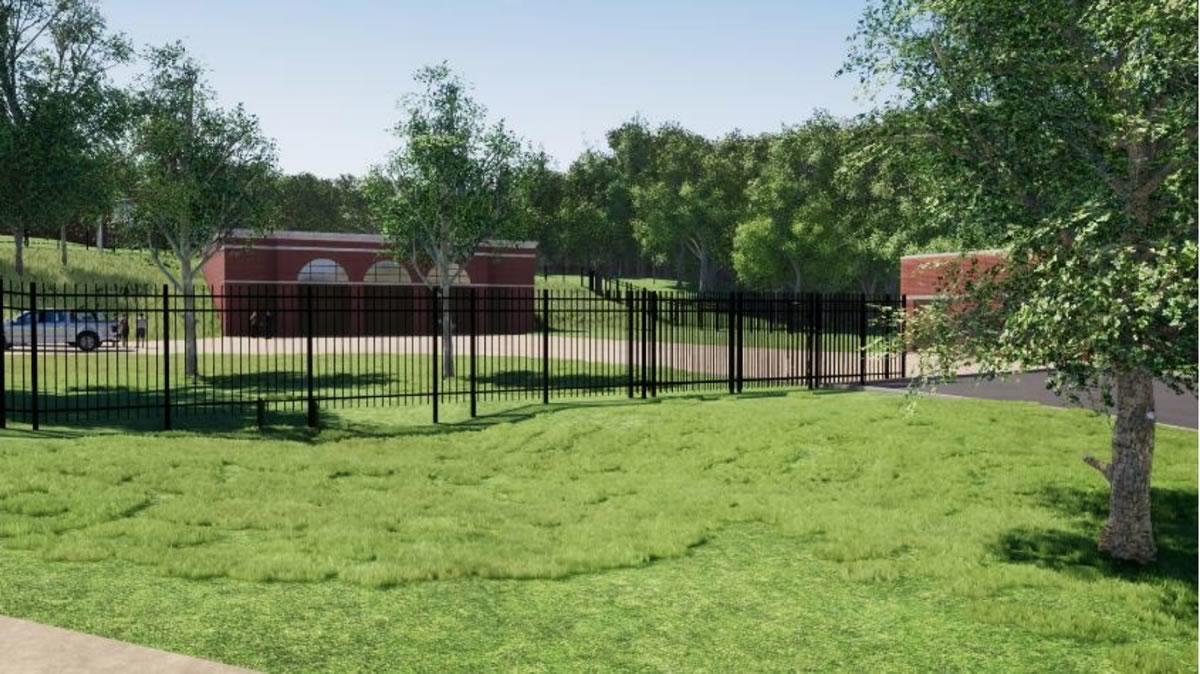
One of the renderings of the project. Much of the facility would be underground.
Albany is an old city, built atop layers of old infrastructure. And it's currently taking on a problem that is literally a hundred years -- or more -- in the making.
Large portions of Albany's (very old) sewer system combine both sewage and stormwater. And when it rains a lot, the system can't handle all that water. So the sewage ends up in the Hudson River. Yep, gross. It's a serious environmental and health problem.
But the city and its neighbors are currently working on a plan to address this problem. And the centerpiece is a $45 million project -- what one official called the biggest public works project in a generation -- that would be located in Lincoln Park.
A sewer facility in a park? People are going to have a lot of questions about that. And they brought them to a public meeting this week.
Here's an overview of the project, along with some of the concerns people have....
How did the city end up at this point?
There's a whole tangle of historical threads that lead up to this point, but here's the path to how the city got to this place, boiled down.
Before there was a city of Albany, there was a stream -- with many branches -- that ran through the heart of the land that's now Albany and it emptied into the Hudson River.
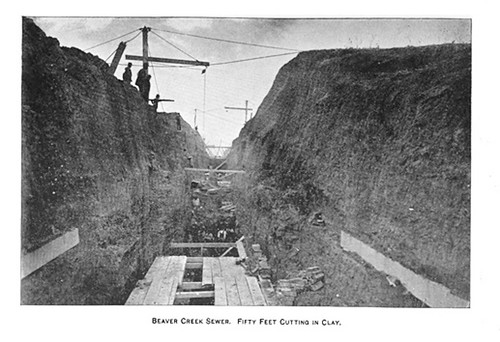
Construction of the Beaver Creek sewer in the late 19th century. / from the AlbanyGroup Archive on Flickr
As the city developed and spread to the west, this stream -- the Beaver Creek -- was used for wastewater and/or covered over segment by segment. By 1884 there were maps of sections along the creek that had sewage contamination problems. By 1940, every part of the old creek was piped underground as a sewer, its branches carrying both sewage and stormwater -- a "combined" sewer. By 1946 there are maps noting flooding problems along parts of the sewer line's branches.
And the city has more or less been wrestling with this situation ever since. The Beaver Creek sewer line and its branches now drain 5.2 square miles of the city's geographic heart. When weather conditions are dry, it handles the job. But when it rains a fair amount, the system -- remember it combines both sewage and stormwater -- can't handle all the extra water. So it overflows into the Hudson River at an outlet near the Port of Albany known as the "Big C." These overflows happen 45 times a year on average and end up discharging about 532 million gallons of combined sewer water into the Hudson.
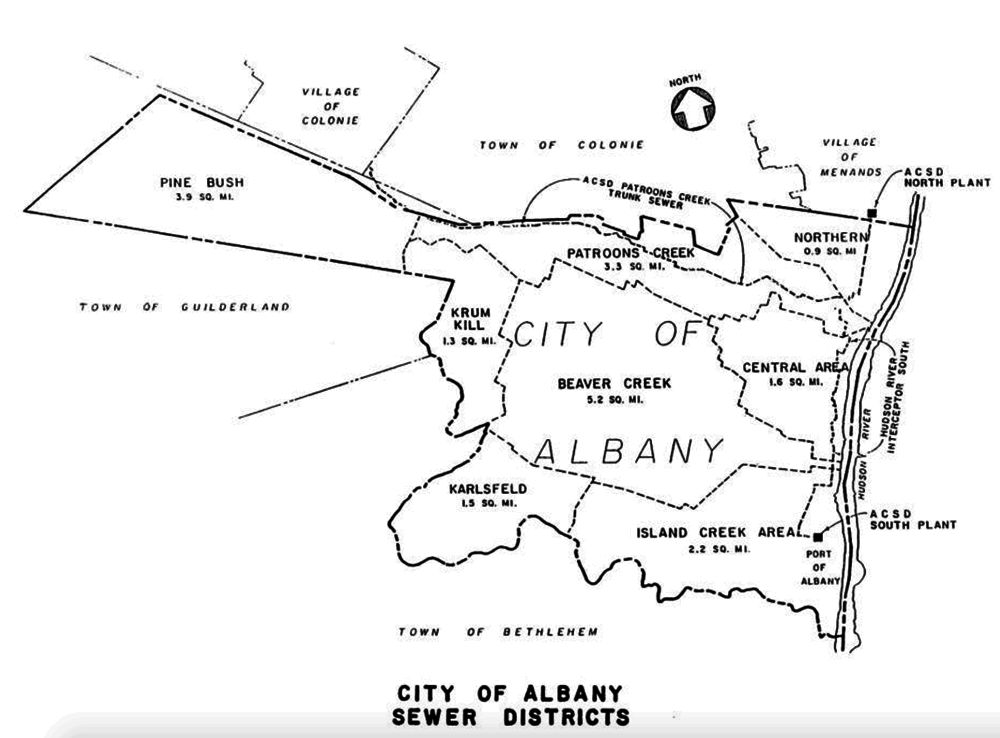
A map of the city's sewer districts from a water department presentation about the Beaver Creek project.
These combined sewer overflows -- from the Big C and other places along the Hudson River -- are a big problem, and the Beaver Creek sewer is one of the biggest parts of that problem. The communities on this section of the river -- the cities of Albany, Cohoes, Rensselaer, Troy, and Watervliet, and the village of Green Island -- are part of a consent order with the state that requires them to work together on a $136 million plan to address the issue.
The Albany Water Board -- which owns the city's water and sewer systems -- is on the hook for $60 million of that. And the city and water department have engaged in all sorts of projects in recent years to better handle stormwater (it is perhaps the most frequently discussed topic at planning board meetings).
But the centerpiece of both the water board's contribution and the overall plan is a $45 million project to significantly cut down on the amount of untreated water that's discharged from this Beaver Creek sewer line.
What's involved?
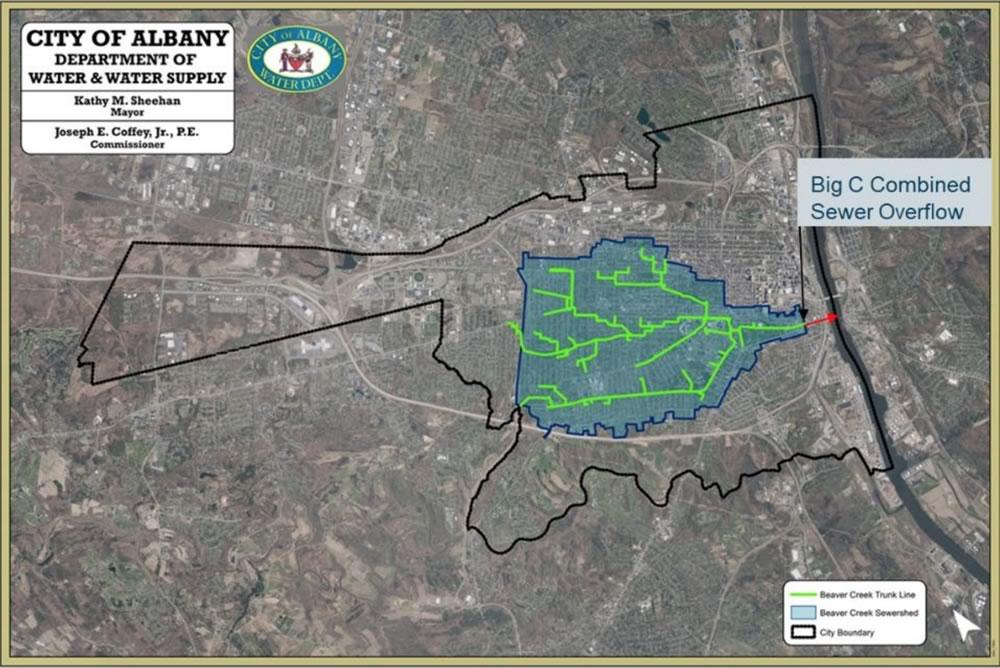
The Beaver Creek sewer system
So what is this $45 million undertaking, the Beaver Creek Clean River Project? The facility would be attached to the Beaver Creek sewer line and it would have two main functions, as officials explained Monday at a meeting at the Thomas O'Brien Academy of Science and Technology (TOAST):
+ Screen out debris that's in the water -- rags, trash, leaves, anything like that. The stuff would be captured, compacted, and then trucked away to a landfill.
+ Treat the water with chlorine to kill microbes in it. Joe Coffey, Albany's water department commissioner, said the facility will be using the same sort of liquid chlorine used in swimming pools.
The new facility would operate May through October to coincide with the recreational season on the river. The operational goal for it would be to clean roughly 300 million gallons of water per year, significantly decreasing the amount of combined sewer water discharged into the Hudson.
The cost of the $45 million project would be offset in part by a $10 million grant.
Why this spot?
The water department is proposing to build this facility at the eastern end of the old Beaver Creek ravine in Lincoln Park, near Martin Luther King Jr Boulevard at the access road for TOAST. Officials say they picked that site for a few reasons:
+ The various branches of the Beaver Creek sewer system converge at Delaware Ave, so the facility has to be somewhere east of there.
+ Much of the industrial area near the Hudson River is in the 100-year floodplain, which they say makes it an imprudent location. (The city's zoning, following state guidelines, also prohibits building this sort of infrastructure in the floodplain.)
+ The section of the city bordered by Lincoln Park on the west and the floodplain on the east is densely developed.
+ And building the facility at the ravine allows the water department to take on two other problems: It has to eventually build a bypass sewer line there so it can address sinking related to the old sewer line. And the current setup of the sewer line -- with grates that open into the ravine -- creates an environment that is, to put it simply, very often gross and stinky.
This facility would largely be underground, built into a hillside. To go along with the sewer infrastructure, the project would also include various new amenities for the public -- possibly a wetland with a boardwalk, an outdoor classroom, or maybe a meditation labyrinth. And the section of the ravine where the current sewer vents, and sometimes discharges sewage, would be raised 8-10 feet to keep that from happening.

You can click on the image for a larger view.
"We're really trying to make a part of Lincoln Park that right now is a health hazard periodically, it's not really usable and it's not a fun part to walk through, we want to make where you want to walk through it and enjoy the features there," Joe Coffey told the crowd Monday.
Skepticism
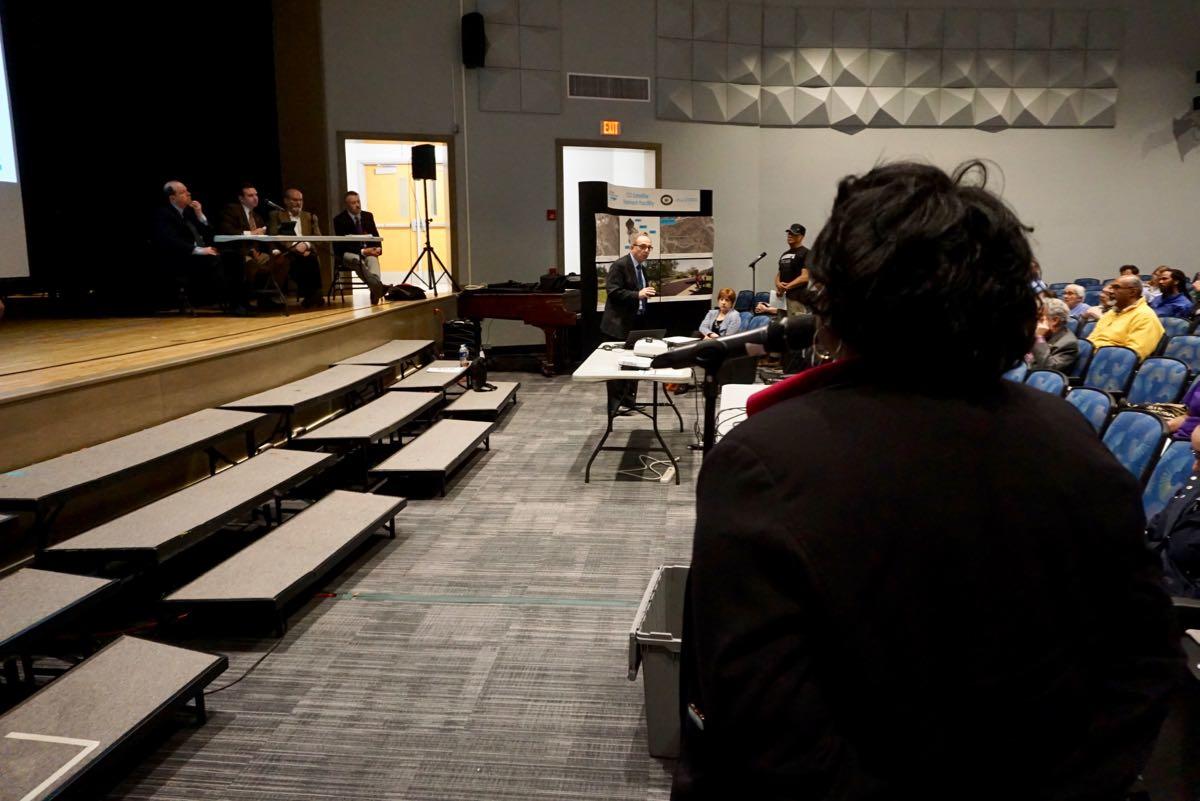
This would be a sewer facility, in a park, next to a school, in a residential neighborhood. And that's raised some eyebrows -- understandably so.
Many of the people who spoke during the question period at Monday's meeting expressed skepticism and concerns about the project and its effects. This isn't a complete list, but it covers many of the topics that were frequently mentioned:
Traffic and school operation
Multiple people expressed worries about how reconfiguring the access road for TOAST -- one possible version includes a driveway that would loop round back to Delaware instead of MLK Blvd -- would affect traffic for the school and neighborhood generally, which residents said is already a problem. Coffey said the project will involve a traffic study.
Others said they were worried about the volume of truck traffic to the facility. Coffey said it would vary based on how many times the facility has to switch on. But, as an example, he said they expected there to be one shipment of chlorine per week during the operating season. (He said the Lincoln Park pool currently gets 1-2 shipments per work during its season.)
Odors and monitoring
Another frequently-mentioned concern: possible odors from the facility and effects on air quality. Coffey said much of the facility's operations would be below ground, and it will be using activated carbon to filter the air that it discharges. People said they would also like to see some kind of ongoing monitoring to make sure the facility was doing what it was supposed to do in terms of controlling odors and chemicals.
Coffey said odor control is worth watching and the department can do monitoring.
The justice of this location
Probably the biggest issue that people raised revolved around the issue of whether it's fair that that facility would be located in this neighborhood.
Simone Freeman -- a resident of Summit Ave -- said it felt like the facility was being dumped on a neighborhood that already doesn't get the attention that it deserves. "I believe this project is laced with socioeconomic injustice," she said.
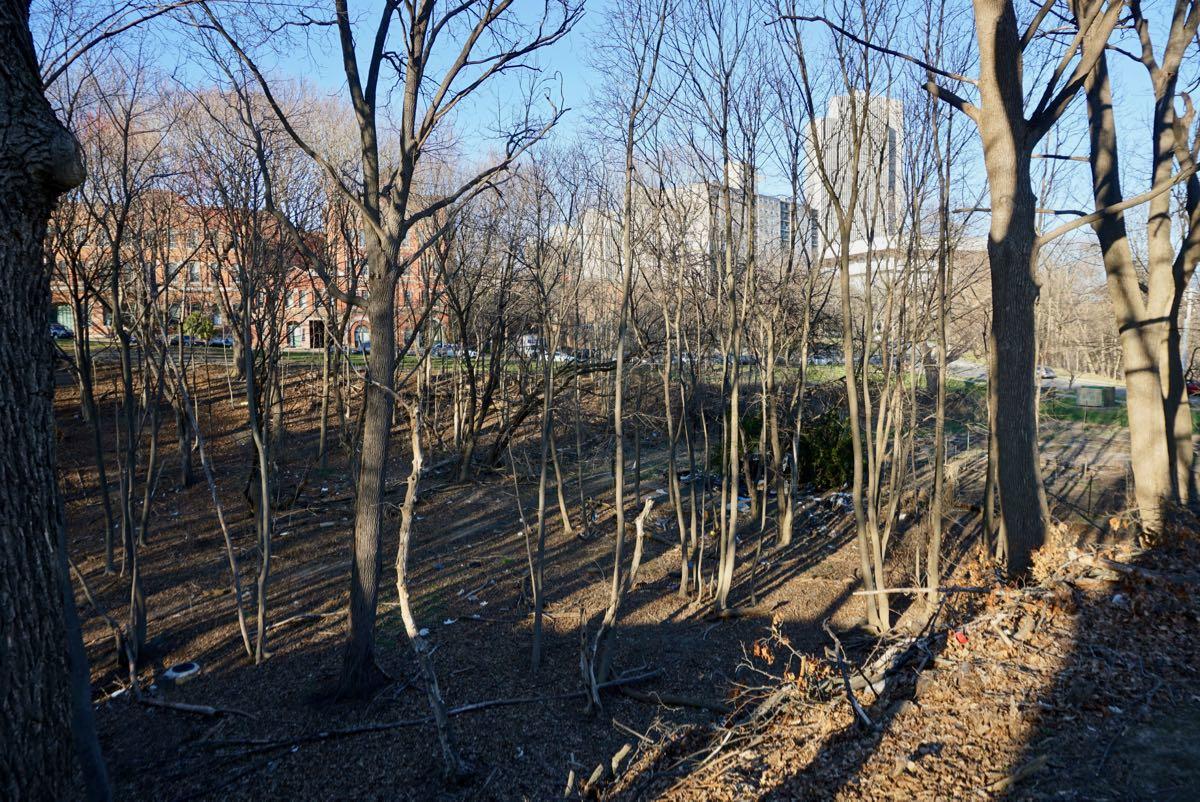
The ravine roughly around the spot where the facility would be.
Other people noted that there had been ongoing problems related to the Beaver Creek ravine, and they were only now being addressed when a sewer facility was on the table.
And Dannielle Hille had many pointed questions about the project, including the claim that the facility isn't a sewage treatment plant. (There was some back and forth with Coffey about this point. It's probably fair to say that though the project might not qualify as such from an engineering or technical perspective, it's going to appear like it's one to the general public.) And she questioned why other parts of the city had gotten "green" projects related to handling stormwater, but this neighborhood is getting the sewer facility.
On that last point, Aaron Mair -- the longtime environmental justice advocate and former national Sierra Club president -- interjected that in his mind this project is green infrastructure -- on top of "gray." And he said the current state of conditions in the ravine are a health hazard. (Mair speaks with a lot of presence and authority and he temporarily became the center of the meeting during his interjection.)

Aaron Mair
"All in all," Mair told the crowd, "the community, from an environmental health standpoint, will be better served. I would encourage the community to really work on that green project, as well as if there's an opportunity to get additional monitoring, that would be an extra community benefit as well."
At the start of Monday's meeting, mayor Kathy Sheehan acknowledged there's a history -- both locally and nationally -- of projects being built in communities without their input. She said that wariness is understandable. But she also thinks this project is a step forward.
"To me this is an environmental justice project because we are eliminating a public health hazard that has existed in this neighborhood for decades. And to be able to have a facility which operates very few days a year, that is doing something really cool that I think the kids at TOAST and at Hackett [Middle School] and throughout our school system can get really excited about because this is fixing a problem that has existed for hundreds of years," Sheehan said after Monday's meeting. "So if I didn't believe that this was going to net improve the environment in this community we wouldn't be standing here talking about it."
Communication and community
There was one other overarching theme at Monday's meeting: People said they just didn't feel like they had been kept in the loop on such an important project. Many said they hadn't heard about the public meeting April 10, or they'd heard too late.
Joe Coffey, the water department commissioner, said the department has done outreach via social media, Common Council members, and leaflets.
"You can always do a better job there's no question about that," Coffey said about getting the word out. "But I think again the members who have come out who are passionate and engaged in the project now that we have their contact information we can start that [email] listserv and expand a notification to every mechanism possible."
One of the members of the public said in her comment that she hoped the project would have a community advisory panel, which could help not just with providing input but also in getting the word out to people about developments. And Albany County legislator Sam Fein, who represents the area, echoed that call.
Coffey seemed open to that idea. He said there will be more meetings, and he'd be willing to meet with smaller groups to talk over concerns and gather feedback. He said the project next has a meeting scheduled with A Village for May 3.
Earlier
Say Something!
We'd really like you to take part in the conversation here at All Over Albany. But we do have a few rules here. Don't worry, they're easy. The first: be kind. The second: treat everyone else with the same respect you'd like to see in return. Cool? Great, post away. Comments are moderated so it might take a little while for your comment to show up. Thanks for being patient.
Comments
One of the earliest bits of Albany "History" I was told claimed that Lincoln Park had been constructed as an emergency catch basin in case of floods
... said Eric Scheirer Stott on Apr 25, 2018 at 4:47 AM | link
Do I understand it right that since natural drainage path for that area - Beaver creek - is converted into a sewer, there is nothing that can be done to separate combined sewer?
Well, it may be possible to build a full new system and restore the creek - but cost would be astronomical..
... said Mike on Apr 25, 2018 at 10:08 AM | link
NOT an environmental justice issue. The infrastructure needs repair. The failing system preexists the current neighborhoods. The benefit to all far outweighs any negative impact. Just like sanitation routes that started before the demographics changed within those routes, history cannot be changed just because a different present exists. Negative impacts can be mitigated if they exist, but overall benefits far exceeds such inconveniences.
... said ace on Apr 25, 2018 at 10:09 AM | link
Seems pretty clear they didn't have much choice in the location, that's just where the plumbing goes. The finished product also sounds like an improvement from what's there now.
... said Danny on Apr 25, 2018 at 10:23 AM | link
In the presentation, the beaver creek sewer district (all the property in the city that drains into the combined system within these boundaries) is 5.2 miles. Twenty five percent of the city. Can anyone estimate how many miles of streets that is? Let's consider the cost of separation for each and every one of those streets in the same timeline of this project.
1) Over the course of three construction seasons, each street would be dug up, and repaved. New curbs and driveway aprons are likely.
2) Each Street would get a new sanitary sewer main
3) New Trunk line sewers woud need to connect the sanitary flow to the plant
3) Every single home would get a new lateral to this sewer main
4) Every home with a roof drain would get a modified lateral
-These costs would be born by the city, amortized into the water rate. Consider the complaints from residents a this meeting for the construction of facility, less than .5 acre in size, wholly contained within a park. Then think of the absolute bonkers level of complaints about spending more than a BILLION dollars in three years in order to do separation of 25% of our streets. Let the man hours and truck traffic sink in for that. 1 our of every 3 streets in these 5 square miles under complete reconstruction in any given year for three years. There aren't enough contractors in upstate NY to even tackle that job.
Then consider, that total separation is not necessary comply with the Consent Order. The situation is not ideal. But the city is addressing a need, creating a solution to several historic problems, and it MUST be done.
Maybe what would have been a better tactic was to propose the facility in the center of the residential area, south of the park, and then "compromise" to the park site.
... said Rain Rain go Away on Apr 25, 2018 at 11:46 AM | link
The century old infrastructure problem seems to have been established.......Fluids follow gravitational forces, so collecting sewage and rain/snow fluids at a point above the 100-year floodplain of the larger liquid force (Hudson River) makes sense. Property owners in the collection point need to be bought out if necessary. Outcome projections, both liquid and airborne need to be provided for public discussion and moving forward in a fair manner does make sense.
The suggests some of this is underway with professionals involved at critical points. Municipal bonds can help solve the financial part of the problem. Local resources needs to be prioritized to help where possible. The NYS waste-water treatment program could be used.
... said Jim Schaefer on Apr 25, 2018 at 12:30 PM | link
Obviously the solution is to build a very tall, $45 million umbrella, five square miles in surface area. Failing that, this facility seems like a good idea.
Also, the CAD plan explains that small, fenced-in area across from TOAST as a combined sewer access point. I often wondered what that was and why it needed so many 'keep out' signs.
... said Paul on Apr 25, 2018 at 2:26 PM | link
This is more pretty conventional grey infrastructure.
What is needed in addition, and which could possibly cut costs for the treatment facility, is a number of upstream green catchment areas that would slow the absorption of rainwater in the first place during heavy rains. Lots of other cities are doing this. These catchments can be built to have the full appearance of small parks/rain gardens, and only fill with water during really heavy rains.
So - several neighborhoods could benefit from these little rain parks while lessening the whole problem of combined sewer and storm water.
Rain Rain go Away is right, the cost of separating the two systems is stupidly high and impractical. But there are multiple paths to solving this problem, and we should pursue all of them.
... said stan on Apr 26, 2018 at 7:52 AM | link
Has anyone asked the Civil and Environmental Engineering Dept at RPI to assist with this project? I'm pretty confident that the faculty and students would love the opportunity to get involved and offer their help and expertise for how to address the issues and offer a cost and health conscious green solution.
... said Barb Ruel on Apr 26, 2018 at 8:44 AM | link
@Stan - The water department has been putting in rain catchment ponds where possible over the past couple years. They just finished the one at Ryckman next to the ball fields last year, did a large project linking Elberon Place to to Washington Park Lake, and re-did Quail street using pavements and plantings to absorb stormwater. So the city is attacking this issue on all fronts. This Beaver Creek plan is one of many items, and not the first thing they are doing.
... said BethAM on Apr 26, 2018 at 10:21 AM | link
Why isn't Albany County involved in solving this sewage problem? They operate both North & South Sewage Treatment Plants. Both plants need to increse treatment capacity to fix this problem.
It doesn't make sense to spend $45 Million for a plant that will only operate approximately 28 rain days from May to November and only fix half of the sewage problem.
Albany Water Board lacks the expertise to operate a sewage treatment plant. The propose Lincoln Park waste water with chlorine may affect the operation at the South Plant. We can't both the County and City doing their own thing it doesn't make sense.
Albany Water Board should just fix the water and sewer pipes!
said Jim Lafferty
... said Jim Lafferty on May 2, 2018 at 7:29 AM | link
@Jim
"Why isn't Albany County involved in solving this sewage problem?"
#1 - the county DID invest more than $ 8m to add disinfection at their two plants
#2 - the county does not own this sewer pipe, nor does it hold the CSO permits. The county simply collects sewage into a large interceptor and treats it.
"They operate both North & South Sewage Treatment Plants. Both plants need to increase treatment capacity to fix this problem. "
#3 To increase capacity the county would have to increase the size of the interceptor pipe, and undergo a massive expansion to treat what is essentially rainwater. that means when it's not raining, the county has paid for larger pumps, disinfection, and infrastructure that is not being used. The cost of these improvements would be astronomical and worse yet, the cost benefit would be very tiny.
"It doesn't make sense to spend $45 Million for a plant that will only operate approximately 28 rain days from May to November and only fix half of the sewage problem."
There's 500 MILLION gallons of combined sewage coming from big-C every year. In order to disinfect that flow, and bring the river into federal and state water quality compliance, there needs to be a facility capable of disinfection at this outfall. There are far more that 28 wet weather days in a season. What confuses me is that you're advocating for larger sewer treatment plants (a $100m expense on the low end to address this issue) and against a $45m satellite facility that would do the same, but calling the $45m expense a waste.
"Albany Water Board lacks the expertise to operate a sewage treatment plant. The propose Lincoln Park waste water with chlorine may affect the operation at the South Plant. We can't both the County and City doing their own thing it doesn't make sense. "
Are you making the claim that the county has no idea, understanding, or ability to weigh the impact of this facility on theirs? they're part of the long term control plan process. OF COURSE they're for this project. See my comments above about sensible costs.
"Albany Water Board should just fix the water and sewer pipes!"
#1 they are fixing pipes all over the city
#2 the Lincoln park pipes need to be fixed
#3 the CSO is not a "broken pipe" problem it's a system problem.There are 5 square miles of combined pipes in the beaver creek sewershed. that's 5 square miles of a city, with thousands of homes, businesses, catch basins, roof drains, and sewer laterals - all go into the combined system. When you say "fix" do you mean spend the next three years digging up every single street and separating it? If $45m is a waste, where does the city come across the backbreaking $billion it would need to separate all those pipes? No one likes paying for sewers.
No one like sewage. but until a time comes in which we can put an end to defecating, doing dishes, washing our clothes and moving rainwater away from our basements we need to continue to maintain and improve the systems that manage this wastewater and stormwater. Sometimes unpopular choices have to be made and we can't have it all, for free. That's not how it works.
... said Stop flushing then! on May 4, 2018 at 11:09 AM | link
There are 180 thousand people in the Capital Region served by CSOs. There's a $136m plan to abate these discharges. This plan will bring us in compliance with a consent decree mandating we address a violation of the clean water act. until the program is done, we're in violation of the clean water act every day. Sounds awful, no?
But then think, while we're up in arms over a single $45m project,
The City of Middletown, Ohio, population 48,813, entered into a 25yr, $269 million consent decree in February of this year.
https://www.epa.gov/newsreleases/epa-doj-reach-agreement-city-middletown-prevent-sewage-discharge-great-miami-river
$270m. Twice the price. 1/3 the population. OUCH.
... said Drain Man on May 4, 2018 at 11:18 AM | link
How much will this project increase water/sewer bills in the city?
... said Lyke on May 7, 2018 at 10:02 PM | link
There is an alternative to gravity sewer systems.Vacuum sewers can be cheaper and easier to install, since they can use smaller diameter flexible pipes and can be routed around onstacles more easily. Buildings could be disconnected from the combined sewer and connected to the new vacuum line.
I wonder if the City looked into these.
... said Zed Fechten on May 8, 2018 at 8:03 PM | link